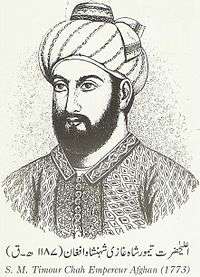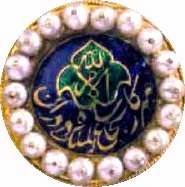Timur Shah Durrani
| Timur Shah Durrani تیمور شاہ درانی | |||||
|---|---|---|---|---|---|
| Emir | |||||
 | |||||
| 2nd Emperor of the Durrani Empire | |||||
| Reign | 16 October 1772 – 18 May 1793 | ||||
| Coronation | 1772 | ||||
| Predecessor | Ahmad Shah Durrani | ||||
| Successor | Zaman Shah Durrani | ||||
| Born | 1748 | ||||
| Died |
18 May 1793 (aged 45) Kabul, Durrani Empire, now Afghanistan | ||||
| Burial |
19 May 1793 Maqbara-i-Timur Shah, Kabul | ||||
| Spouse |
Gauhar-un-Nissa Begum Maryam Begum[1] Gauhar Shad Begum[2] Ayesha Durrani[3] | ||||
| Issue |
Zaman Shah Durrani Mahmud Shah Durrani Shah Shujah Durrani | ||||
| |||||
| Dynasty | Durrani | ||||
| Father | Ahmad Shah Durrani | ||||
| Mother | Mimtta | ||||
| Religion |
 | ||||
Timur Shah Durrani, (Pashto, Persian, Urdu, Arabic: تیمور شاہ درانی ; 1748 – May 18, 1793) was the second ruler of the Durrani Empire, from October 16, 1772 until his death in 1793.[4] An ethnic Pashtun, he was the second child and eldest son of Ahmad Shah Durrani.
Early life
Timur Shah was born in 1748 and had a quick rise to power by marrying the daughter of the Mughal Emperor Alamgir II.
Victory of Punjab
He received the city of Sirhind as a wedding gift and was later made the Governor of Punjab, Kashmir and the Sirhind district in 1757 (when he was only 9 years old), by his father Ahmad Shah Durrani for one year, from May 1757 until April 1758. Timur Shah Durrani was defeated by the Sikhs in the Battle of Gohalwar (Amritsar,1757).
The Sikhs, also assisted by Adina Beg Khan, Governor of the Julundur Doab, along with Raghunath Rao who was leading the Maratha Empire, forced Timur Shah and Jahan from Punjab and put in place their own government under Adina.
Heir of the Durrani dynasty
When Timur Shah succeeded his father in 1772, the regional chieftains only reluctantly accepted him and most of his reign was spent reasserting his rule over the Durrani Empire. He was noted for his use of the Bala Hisar Fort in Peshawar, as the winter capital of the Durrani Empire[5]
Reforms
During his reign, the Durrani Empire began to shrink. In an attempt to move away from disaffected Pashtun tribes, he shifted the capital from Kandahar to Kabul and chose Peshawar as the winter capital in 1776.[6] His court remained influenced by Persian culture and he became reliant on the Qizilbash bodyguard for his personal protection.
Expulsion of Abdul Qadir Khan Durrani
In 1776, Timur Shah compelled his uncle Abdul Qadir Khan Durrani to leave Afghanistan. Abdul left Afghanistan and sent his family including his: wife Zarnaab Bibi, sisters Azer Khela and Unaar Khela, brother Saifullah Khan Durrani, nephews Mohammad Umer Durrani, Basheer Ahmad Khan Durrani and Shams ur Rehman Durrani and two sons, Faizullah Khan Durrani and Abdullah Khan Durrani to Akora Khattak, in present-day Khyber Pakhtunkhwa. He himself went to Damascus (Syria), where he (Abdul Qadir Khan Durrani) died in 1781.
Recovering lost territories
Timur Shah Durrani secured Multan from the Sikhs in 1780, his forces then defeated the Sikhs at Rohtas, he then secured Bhawalpur and Kashmir.[7]
Attempts to rescue Shah Alam II
By 1788 he even attempted unsuccessfully to ford the plains of Punjab to rescue his brother-in-law the emperor Shah Alam II who was blinded by a eunuch Ghulam Qadir, unable to succeed he wrote a letter to Charles Cornwallis, 1st Marquess Cornwallis, requesting that the British protect the Mughal dynasty.[7]
Personal life
Timur Shah himself left twenty-four sons,[6] and the succession struggle that followed his death began the process of undermining the authority of the Durrani authority.[6] Under Timur Shah's eventual successor, Zaman Shah Durrani, the empire disintegrated.[6] In 1797 Shah Zaman, like his father and grandfather before him, decided to revive his fortunes and fill his treasuries by ordering a full-scale invasion of Hindustan, the time-honoured Afghan solution to cash crises.[6]
Timur Shah prided himself on being a man of taste. He revived the formal gardens of the Bala Hisar Fort in Kabul, first constructed by Shah Jahan's Governor of Kabul.[8] In this endeavour, he was inspired by his senior wife, Gauhar-un-Nissa Begum, a Mughal princess, the daughter of Emperor Alamgir II,[9] who had grown up in the Delhi Red Fort with its remarkable courtyard.[6] Furthermore, like his Mughal in-laws, he had a talent for dazzling display, such as in the way he dressed and groomed himself. The conflict between his sons Mahmud Shah Durrani, Zaman Shah Durrani, and Shah Shujah Durrani continued after his death.
Death
Timur Shah died in 1793 and was succeeded by his fifth son, Zaman Shah Durrani. His tomb is located in Kabul.
References
- ↑ McChesney, Robert; Mehdi Khorrami, Mohammad (December 19, 2012). The History of Afghanistan (6 vol. set): Fayż Muḥammad Kātib Hazārah’s Sirāj al-tawārīkh. BRILL. p. 89. ISBN 978-9-004-23498-7.
- ↑ Dani, Ahmad Hasan; Mikhaĭlovich Masson, Vadim (January 1, 2003). History of Civilizations of Central Asia: Development in contrast : from the sixteenth to the mid-nineteenth century. UNESCO. p. 289. ISBN 978-9-231-03876-1.
- ↑ https://www.wdl.org/en/item/11309/
- ↑ Timur Shah, Ruler of Afghanistan.
- ↑ Caroe, Olaf (1957) The Pathans.
- 1 2 3 4 5 6 William Dalrymple Return of a King: The Battle for Afghanistan pp 9 Bloomsbury Publishing, 4 Feb. 2013 ISBN 140882843X
- 1 2 Gandhi, Rajmohan (14 September 2013). Punjab: A History from Aurangzeb to Mountbatten. Aleph Book Company – via Google Books.
- ↑ William Dalrymple (4 February 2013). Return of a King: The Battle for Afghanistan. Bloomsbury Publishing. p. 10. ISBN 978-1-4088-2843-4.
- ↑ Sarkar, Jadunath (1950). Fall of the Mughal Empire, Volume 2. M. C. Sarkar. p. 92.
External links
| Wikimedia Commons has media related to Timur Shah Durrani. |
- An old portrait of Timur Shah Durrani
- Britannica – Timur Shah (ruler of Afghanistan)
- The British Library – Chronology: from the emergence of the Afghan Kingdom to the Mission of Mountstuart Elphistone, 1747–1809
| Preceded by Ahmad Shah Durrani |
Emir of Afghanistan 16 October 1772– 18 May 1793 |
Succeeded by Zaman Shah Durrani |